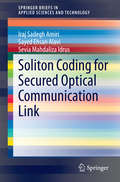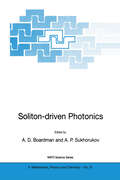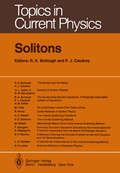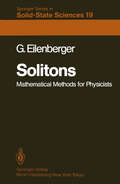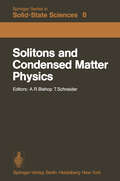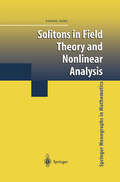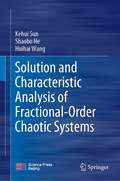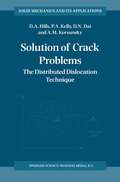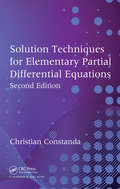- Table View
- List View
Solitary Waves in Dispersive Complex Media: Theory, Simulation, Applications (Springer Series in Solid-State Sciences #149)
by Vasily Y. Belashov Sergey V. VladimirovSoliton Coding for Secured Optical Communication Link (SpringerBriefs in Applied Sciences and Technology)
by Iraj Sadegh Amiri Sayed Ehsan Alavi Sevia Mahdaliza IdrusNonlinear behavior of light such as chaos can be observed during propagation of a laser beam inside the microring resonator (MRR) systems. This Brief highlights the design of a system of MRRs to generate a series of logic codes. An optical soliton is used to generate an entangled photon. The ultra-short soliton pulses provide the required communication signals to generate a pair of polarization entangled photons required for quantum keys. In the frequency domain, MRRs can be used to generate optical millimetre-wave solitons with a broadband frequency of 0–100 GHz. The soliton signals are multiplexed and modulated with the logic codes to transmit the data via a network system. The soliton carriers play critical roles to transmit the data via an optical communication link and provide many applications in secured optical communications. Therefore, transmission of data information can be performed via a communication network using soliton pulse carriers. A system known as optical multiplexer can be used to increase the channel capacity and security of the signals.
Soliton-driven Photonics (NATO Science Series II: Mathematics, Physics and Chemistry #31)
by A. D. Boardman A. P. SukhorukovIt is ironic that the ideas ofNewton, which described a beam of light as a stream ofparticles made it difficult for him to explain things like thin film interference. Yet these particles, called 'photons', have caused the adjective 'photonic' to gain common usage, when referring to optical phenomena. The purist might argue that only when we are confronted by the particle nature of light should we use the word photonics. Equally, the argument goes on, only when we are face-to face with an integrable system, i. e. one that possesses an infinite number of conserved quantities, should we say soliton rather than solitary wave. Scientists and engineers are pragmatic, however, and they are happy to use the word 'soliton' to describe what appears to be an excitation that is humped, multi humped, or localised long enough for some use to be made of it. The fact that such 'solitons' may stick to each other (fuse) upon collision is often something to celebrate for an application, rather than just evidence that, after all, these are not really solitons, in the classic sense. 'Soliton', therefore, is a widely used term with the qualification that we are constantly looking out for deviant behaviour that draws our attention to its solitary wave character. In the same spirit, 'photonics' is a useful generic cover-all noun, even when 'electromagnetic theory' or 'optics' would suffice.
Soliton Management in Periodic Systems
by Boris A. MalomedDuring the past ten years, there has been intensive development in theoretical and experimental research of solitons in periodic media. This book provides a unique and informative account of the state-of-the-art in the field. The volume opens with a review of the existence of robust solitary pulses in systems built as a periodic concatenation of very different elements. Among the most famous examples of this type of systems are the dispersion management in fiber-optic telecommunication links, and (more recently) photonic crystals. A number of other systems belonging to the same broad class of spatially periodic strongly inhomogeneous media (such as the split-step and tandem models) have recently been identified in nonlinear optics, and transmission of solitary pulses in them was investigated in detail. Similar soliton dynamics occurs in temporal-domain counterparts of such systems, where they are subject to strong time-periodic modulation (for instance, the Feshbach-resonance management in Bose-Einstein condensates). Basis results obtained for all these systems are reviewed in the book. This timely work will serve as a useful resource for the soliton community.
Soliton Theory and Its Applications
by Chaohao GuSoliton theory is an important branch of applied mathematics and mathematical physics. An active and productive field of research, it has important applications in fluid mechanics, nonlinear optics, classical and quantum fields theories etc. This book presents a broad view of soliton theory. It gives an expository survey of the most basic ideas and methods, such as physical background, inverse scattering, Backlünd transformations, finite-dimensional completely integrable systems, symmetry, Kac-moody algebra, solitons and differential geometry, numerical analysis for nonlinear waves, and gravitational solitons. Besides the essential points of the theory, several applications are sketched and some recent developments, partly by the authors and their collaborators, are presented.
Solitons (Topics in Current Physics #17)
by R. K. Bullough P. J. CaudreyWith contributions by numerous experts
Solitons: Mathematical Methods for Physicists (Springer Series in Solid-State Sciences #19)
by G. EilenbergerSolitons: Properties, Dynamics, Interactions, Applications (CRM Series in Mathematical Physics)
by R. MacKenzie M. B. Paranjape W. J. ZakrzewskiSolitons were discovered by John Scott Russel in 1834, and have interested scientists and mathematicians ever since. They have been the subject of a large body of research in a wide variety of fields of physics and mathematics, not to mention engineering and other branches of science such as biology. This volume comprises the written versions of the talks presented at a workshop held at Queen's University in 1997, an interdisciplinary meeting wherein top researchers from many fields could meet, interact, and exchange ideas. Topics covered include mathematical and numerical aspects of solitons, as well as applications of solitons to nuclear and particle physics, cosmology, and condensed-matter physics. The book should be of interest to researchers in any field in which solitons are encountered.
Solitons and Chaos (Research Reports in Physics)
by Ioannis Antoniou Franklin J. Lambert"Solitons and Chaos" is a response to the growing interest in systems exhibiting these two complementary manifestations of nonlinearity. The papers cover a wide range of topics but share common mathematical notions and investigation techniques. An introductory note on eight concepts of integrability has been added as a guide for the uninitiated reader. Both specialists and graduate students will find this update on the state ofthe art useful. Key points: chaos vs. integrability; solitons: theory and applications; dissipative systems; Hamiltonian systems; maps and cascades; direct vs. inverse methods; higher dimensions; Lie groups, Painleve analysis, numerical algorithms; pertubation methods.
Solitons and Condensed Matter Physics: Proceedings of the Symposium on Nonlinear (Soliton) Structure and Dynamics in Condensed Matter, Oxford, England, June 27–29, 1978 (Springer Series in Solid-State Sciences #8)
by A. R. Bishop T. SchneiderSolitons in Field Theory and Nonlinear Analysis (Springer Monographs in Mathematics)
by Yisong YangThere are two approaches in the study of differential equations of field theory. The first, finding closed-form solutions, works only for a narrow category of problems. Written by a well-known active researcher, this book focuses on the second, which is to investigate solutions using tools from modern nonlinear analysis.
Solitons in Liquid Crystals (Partially Ordered Systems)
by Lui Lam Jacques ProstSolitons are a well-known and intriguing aspect of nonlinear behavior in a continuous system such as a fluid: a wave propagates through the medium without distortion. Liquid crystals are highly ordered systems without a rigid, long-range structure. Solitons in liquid crystals (sometimes referred to as "walls") have a wide variety of remarkable properties that are becoming important for practical applications such as electroluminescent display. This book, the first review of the subject to be published, contains not only surveys of the existing literature, but presents new results as well.
Solitons in Molecular Systems (Mathematics and its Applications #4)
by DavydovApproach your problems from the It isn't that they can't see the end and begin with the answers. solution. It is that they can't Then one day, perhaps you will see the problem. find the final question. G.K. Chesterton. The Scandal of 'The Hermit Clad in Crane Father Brown 'The Point of a Pin'. Feathers' in R. van Gulik's The Chinese Maze Murders. Growing specialization and diversification have brought a host of mono graphs and textbooks on increasingly topics. However, the "tree" of knowledge of mathematics and related fields does not grow only by putting forth new branches. It also happens, quite often in fact, that branches which were thought to be completely disparate are suddenly seen to be related. Further, the kind and level of sophistication of mathematics applied in various sciences has changed drastically in recent years: measure theory is used (non-trivially) in regional and theoretical economics; algebraic geometry interacts with physics; the Minkowsky lemma, coding theory and the structure of water meet one another in packing and covering theory; quantum fields, crystal defects and mathematical pro gramming profit from homotopy theory; Lie algebras are relevant to filtering; and prediction and electric engineering can use Stein spaces. And in addition to this there are such new emerging subdisciplines as "complete integrable systems", "chaos, synergetics and large-scale order", which are almost impossible to fit into the existing classifica tion schemes. The draw upon widely different sections of mathematics.
Solitons in Physics, Mathematics, and Nonlinear Optics (The IMA Volumes in Mathematics and its Applications #25)
by Peter J. Olver David H. SattingerThis IMA Volume in Mathematics and its Applications SOLITONS IN PHYSICS, MATHEMATICS, AND NONLINEAR OPTICS is based on the proceedings of two workshops which were an integral part of the 1988-89 IMA program on NONLINEAR WAVES. The workshops focussed on the main parts of the theory of solitons and on the applications of solitons in physics, biology and engineering, with a special concentration on nonlinear optics. We thank the Coordinating Committee: James Glimm, Daniel Joseph, Barbara Keyfitz, An Majda, Alan Newell, Peter Olver, David Sattinger and David Schaeffer for drew planning and implementing the stimulating year-long program. We especially thank the Workshop Organizers for Solitons in Physics and Mathematics, Alan Newell, Peter Olver, and David Sattinger, and for Nonlinear Optics and Plasma Physics, David Kaup and Yuji Kodama for their efforts in bringing together many of the major figures in those research fields in which solitons in physics, mathematics, and nonlinear optics theories are used. A vner Friedman Willard Miller, Jr. PREFACE This volume includes some of the lectures given at two workshops, "Solitons in Physics and Mathematics" and "Solitons in Nonlinear Optics and Plasma Physics" held during the 1988-89 LM. A. year on Nonlinear Waves. Since their discovery by Kruskal and Zabusky in the early 1960's, solitons have had a profound impact on many fields, ranging from engineering and physics to algebraic geometry.
Solitons, Instantons, and Twistors (Oxford Graduate Texts in Mathematics)
by Maciej DunajskiMost nonlinear differential equations arising in natural sciences admit chaotic behaviour and cannot be solved analytically. Integrable systems lie on the other extreme. They possess regular, stable, and well-behaved solutions known as solitons and instantons. These solutions play important roles in pure and applied mathematics as well as in theoretical physics where they describe configurations topologically different from vacuum. While integrable equations in lower space-time dimensions can be solved using the inverse scattering transform, the higher-dimensional examples of anti-self-dual Yang-Mills and Einstein equations require twistor theory. Both techniques rely on an ability to represent nonlinear equations as compatibility conditions for overdetermined systems of linear differential equations. The book provides a self-contained and accessible introduction to the subject. It starts with an introduction to integrability of ordinary and partial differential equations. Subsequent chapters explore symmetry analysis, gauge theory, vortices, gravitational instantons, twistor transforms, and anti-self-duality equations. The three appendices cover basic differential geometry, complex manifold theory, and the exterior differential system.
Solomon Golomb’s Course on Undergraduate Combinatorics
by Solomon W. Golomb Andy LiuThis textbook offers an accessible introduction to combinatorics, infused with Solomon Golomb’s insights and illustrative examples. Core concepts in combinatorics are presented with an engaging narrative that suits undergraduate study at any level. Featuring early coverage of the Principle of Inclusion-Exclusion and a unified treatment of permutations later on, the structure emphasizes the cohesive development of ideas. Combined with the conversational style, this approach is especially well suited to independent study. Falling naturally into three parts, the book begins with a flexible Chapter Zero that can be used to cover essential background topics, or as a standalone problem-solving course. The following three chapters cover core topics in combinatorics, such as combinations, generating functions, and permutations. The final three chapters present additional topics, such as Fibonacci numbers, finite groups, and combinatorial structures. Numerous illuminating examples are included throughout, along with exercises of all levels. Three appendices include additional exercises, examples, and solutions to a selection of problems. Solomon Golomb’s Course on Undergraduate Combinatorics is ideal for introducing mathematics students to combinatorics at any stage in their program. There are no formal prerequisites, but readers will benefit from mathematical curiosity and a willingness to engage in the book’s many entertaining challenges.
The Solow Model of Economic Growth: Application to Contemporary Macroeconomic Issues (Routledge Studies in Economic Theory, Method and Philosophy)
by Paweł Dykas Tomasz Tokarski Rafał WisłaIn 1956, Solow proposed a neoclassical growth model in opposition or as an alternative to Keynesian growth models. The Solow model of economic growth provided foundations for models embedded in the new theory of economic growth, known as the theory of endogenous growth, such as the renowned growth models developed by Paul M. Romer and Robert E. Lucas in the 1980s and 90s. The augmentations of the Solow model described in this book, excepting the Phelps golden rules of capital accumulation and the Mankiw-Romer-Weil and Nonneman-Vanhoudt models, were developed by the authors over the last two decades. The book identifies six spheres of interest in modern macroeconomic theory: the impact of fiscal and monetary policy on growth; the effect of different returns to scale on production; the influence of mobility of factors of production among different countries on their development; the effect of population dynamics on growth; the periodicity of investment rates and their influence on growth; and the effect of exogenous shocks in the form of an epidemic. For each of these issues, the authors construct and analyze an appropriate growth model that focuses on the description of the specific macroeconomic problem. This book not only continues the neoclassical tradition of thought in economics focused on quantitative economic change but also, and to a significant extent, discusses alternative approaches to certain questions of economic growth, utilizing conclusions that can be drawn from the Solow model. It is a useful tool in analyzing contemporary issues related to growth.
The Solow Model of Economic Growth: Application to Contemporary Macroeconomic Issues (Routledge Studies in Economic Theory, Method and Philosophy)
by Paweł Dykas Tomasz Tokarski Rafał WisłaIn 1956, Solow proposed a neoclassical growth model in opposition or as an alternative to Keynesian growth models. The Solow model of economic growth provided foundations for models embedded in the new theory of economic growth, known as the theory of endogenous growth, such as the renowned growth models developed by Paul M. Romer and Robert E. Lucas in the 1980s and 90s. The augmentations of the Solow model described in this book, excepting the Phelps golden rules of capital accumulation and the Mankiw-Romer-Weil and Nonneman-Vanhoudt models, were developed by the authors over the last two decades. The book identifies six spheres of interest in modern macroeconomic theory: the impact of fiscal and monetary policy on growth; the effect of different returns to scale on production; the influence of mobility of factors of production among different countries on their development; the effect of population dynamics on growth; the periodicity of investment rates and their influence on growth; and the effect of exogenous shocks in the form of an epidemic. For each of these issues, the authors construct and analyze an appropriate growth model that focuses on the description of the specific macroeconomic problem. This book not only continues the neoclassical tradition of thought in economics focused on quantitative economic change but also, and to a significant extent, discusses alternative approaches to certain questions of economic growth, utilizing conclusions that can be drawn from the Solow model. It is a useful tool in analyzing contemporary issues related to growth.
Solution and Characteristic Analysis of Fractional-Order Chaotic Systems
by Kehui Sun Shaobo He Huihai WangThis book highlights the solution algorithms and characteristic analysis methods of fractional-order chaotic systems. Fractal dimensions exist broadly in the study of nature and the development of science and technology. Fractional calculus has become a hot research area in nonlinear science. Fractional-order chaotic systems are an important part of fractional calculus. The book discusses the numerical solution algorithms and characteristic analysis of fractional-order chaotic systems and introduces the techniques to implement the systems with circuits. To facilitate a quick grasp, the authors present examples from their years of work in the appendix. Intended for graduate students and researchers interested in chaotic systems, the book helps one to build a theoretical and experimental foundation for the application of fractional-order chaotic systems.
Solution Architecture With . Net: Learn Solution Architecture Principles And Design Techniques To Build Modern . Net Solutions
by Jamil HallalLearn solution architecture principles and design techniques to build modern .NET solutions
Solution of Crack Problems: The Distributed Dislocation Technique (Solid Mechanics and Its Applications #44)
by D.A. Hills P.A. Kelly D.N. Dai A.M. KorsunskyThis book is concerned with the numerical solution of crack problems. The techniques to be developed are particularly appropriate when cracks are relatively short, and are growing in the neighbourhood of some stress raising feature, causing a relatively steep stress gradient. It is therefore practicable to represent the geometry in an idealised way, so that a precise solution may be obtained. This contrasts with, say, the finite element method in which the geometry is modelled exactly, but the subsequent solution is approximate, and computationally more taxing. The family of techniques presented in this book, based loosely on the pioneering work of Eshelby in the late 1950's, and developed by Erdogan, Keer, Mura and many others cited in the text, present an attractive alternative. The basic idea is to use the superposition of the stress field present in the unfiawed body, together with an unknown distribution of 'strain nuclei' (in this book, the strain nucleus employed is the dislocation), chosen so that the crack faces become traction-free. The solution used for the stress field for the nucleus is chosen so that other boundary conditions are satisfied. The technique is therefore efficient, and may be used to model the evolution of a developing crack in two or three dimensions. Solution techniques are described in some detail, and the book should be readily accessible to most engineers, whilst preserving the rigour demanded by the researcher who wishes to develop the method itself.
Solution of Initial Value Problems in Classes of Generalized Analytic Functions
by Wolfgang TutschkeThe purpose of the present book is to solve initial value problems in classes of generalized analytic functions as well as to explain the functional-analytic background material in detail. From the point of view of the theory of partial differential equations the book is intend ed to generalize the classicalCauchy-Kovalevskayatheorem, whereas the functional-analytic background connected with the method of successive approximations and the contraction-mapping principle leads to the con cept of so-called scales of Banach spaces: 1. The method of successive approximations allows to solve the initial value problem du CTf = f(t,u), (0. 1) u(O) = u , (0. 2) 0 where u = u(t) ist real o. r vector-valued. It is well-known that this method is also applicable if the function u belongs to a Banach space. A completely new situation arises if the right-hand side f(t,u) of the differential equation (0. 1) depends on a certain derivative Du of the sought function, i. e. , the differential equation (0,1) is replaced by the more general differential equation du dt = f(t,u,Du), (0. 3) There are diff. erential equations of type (0. 3) with smooth right-hand sides not possessing any solution to say nothing about the solvability of the initial value problem (0,3), (0,2), Assume, for instance, that the unknown function denoted by w is complex-valued and depends not only on the real variable t that can be interpreted as time but also on spacelike variables x and y, Then the differential equation (0.
Solution of Variational Inequalities in Mechanics (Applied Mathematical Sciences #66)
by Ivan Hlavacek Jaroslav Haslinger Jindrich Necas Jan LovisekThe idea for this book was developed in the seminar on problems of con tinuum mechanics, which has been active for more than twelve years at the Faculty of Mathematics and Physics, Charles University, Prague. This seminar has been pursuing recent directions in the development of mathe matical applications in physics; especially in continuum mechanics, and in technology. It has regularly been attended by upper division and graduate students, faculty, and scientists and researchers from various institutions from Prague and elsewhere. These seminar participants decided to publish in a self-contained monograph the results of their individual and collective efforts in developing applications for the theory of variational inequalities, which is currently a rapidly growing branch of modern analysis. The theory of variational inequalities is a relatively young mathematical discipline. Apparently, one of the main bases for its development was the paper by G. Fichera (1964) on the solution of the Signorini problem in the theory of elasticity. Later, J. L. Lions and G. Stampacchia (1967) laid the foundations of the theory itself. Time-dependent inequalities have primarily been treated in works of J. L. Lions and H. Bnlzis. The diverse applications of the variational in equalities theory are the topics of the well-known monograph by G. Du vaut and J. L. Lions, Les iniquations en micanique et en physique (1972).
Solution Techniques for Elementary Partial Differential Equations
by Christian ConstandaIncorporating a number of enhancements, Solution Techniques for Elementary Partial Differential Equations, Second Edition presents some of the most important and widely used methods for solving partial differential equations (PDEs). The techniques covered include separation of variables, method of characteristics, eigenfunction expansion, Fourier a

